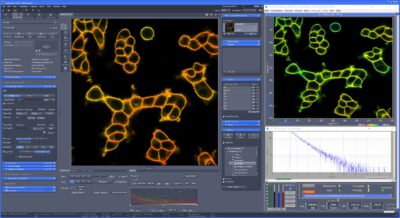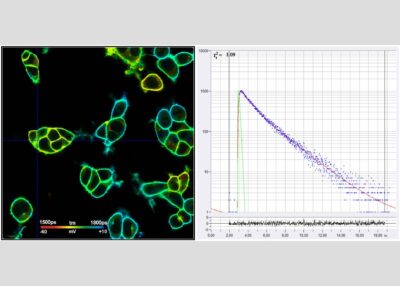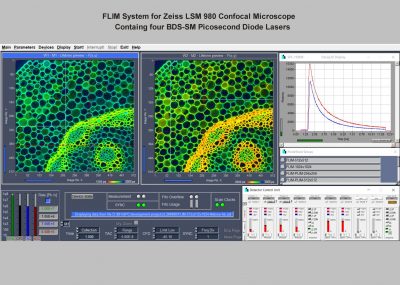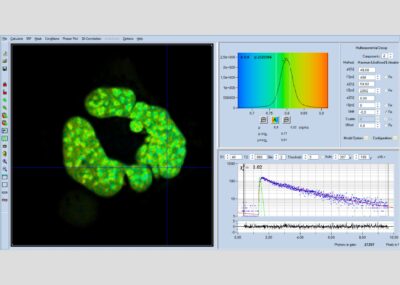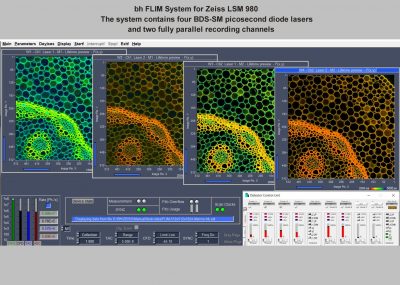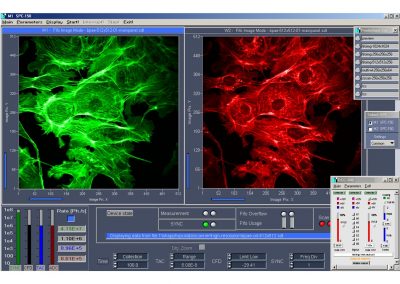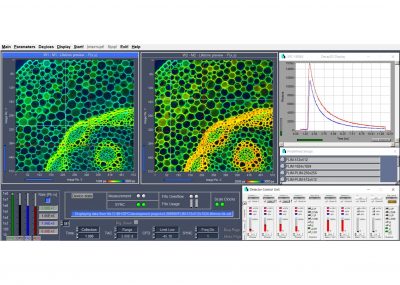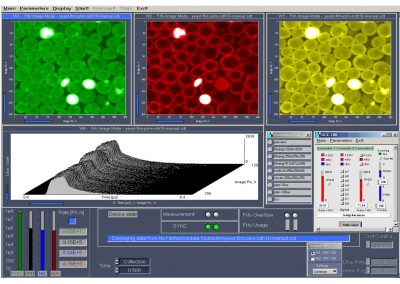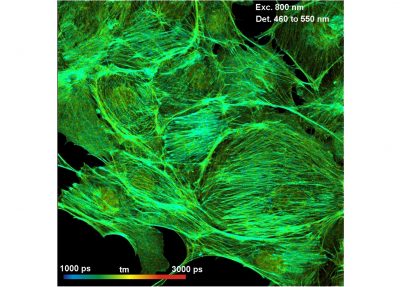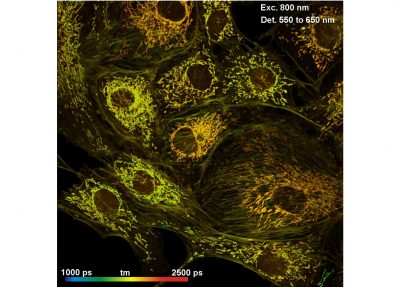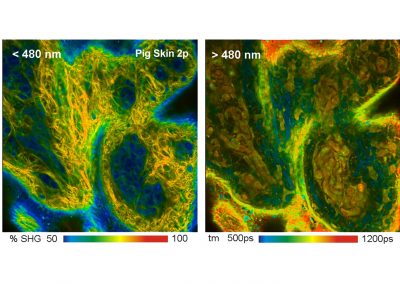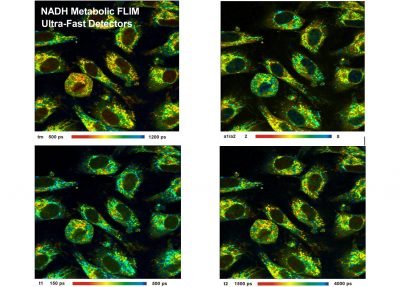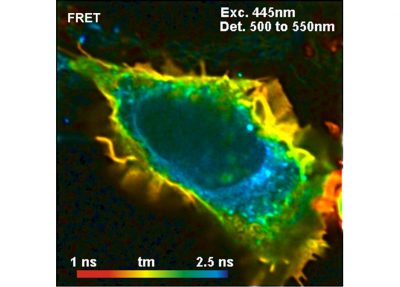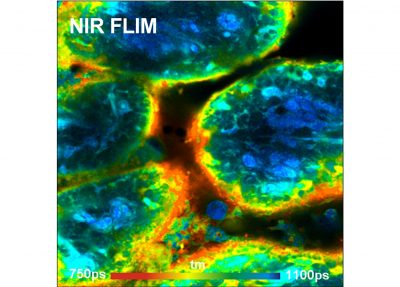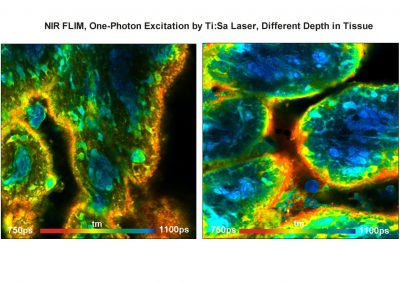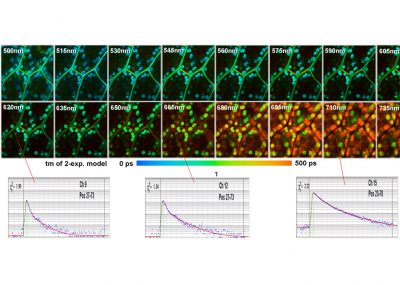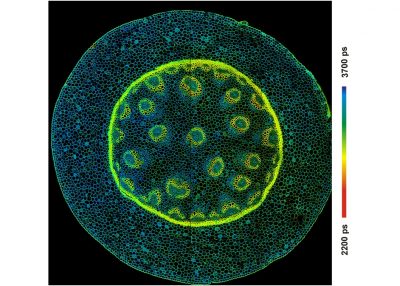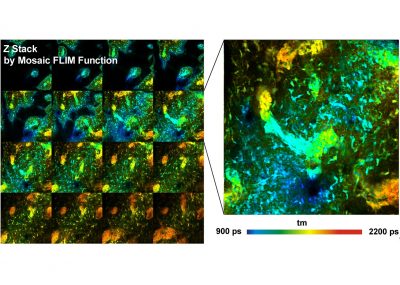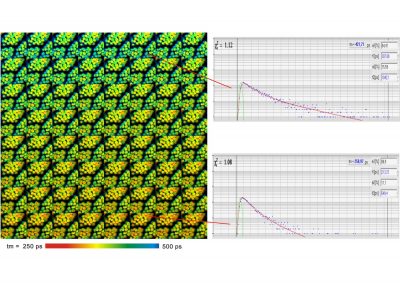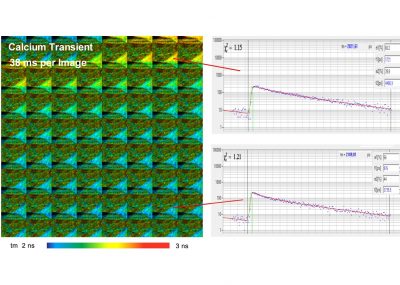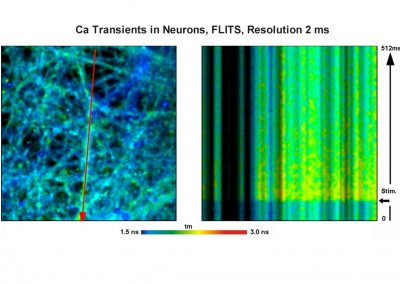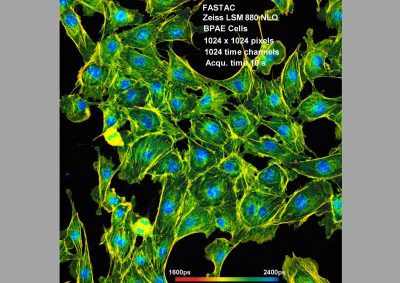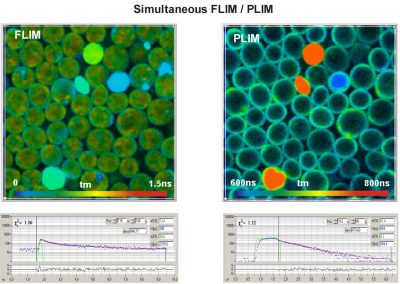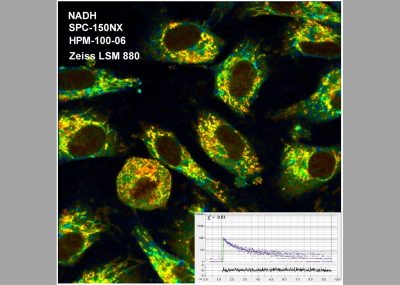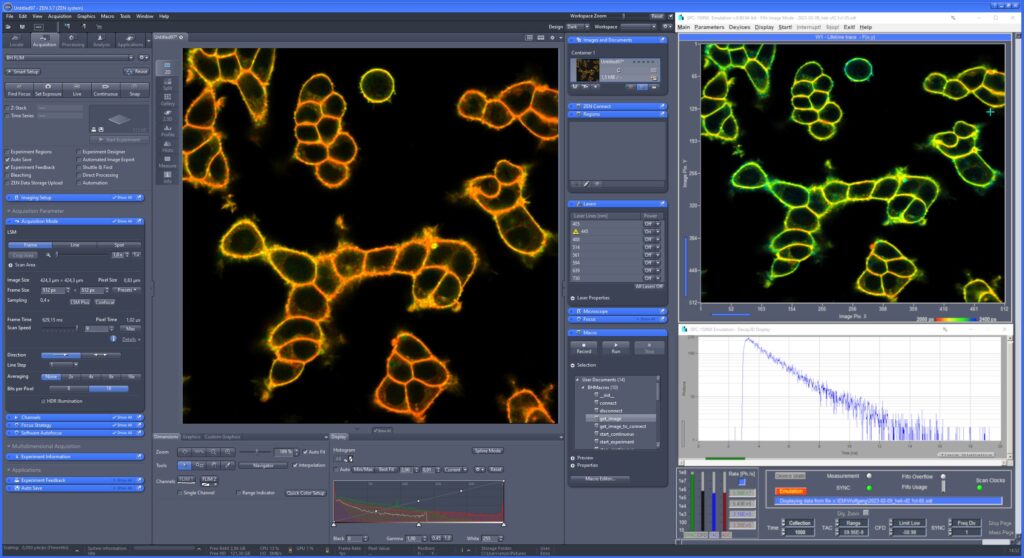
- Two Fully Parallel TCSPC FLIM Channels
- Integration into Zeiss ZEN software via TCP
- Confocal and/or Multiphoton NDD FLIM
- Recording by two bh's Multidimensional TCSPC Technique
- Compact bh Simple-Tau or Power-Tau System
- Two HPM-100-40 GaAsP Hybrid Detectors
- Optional: HPM-100-06 Hybrid Detectors, IRF Width <20 ps FWHM
- Optional: HPM-100-50 Hybrid Detectors for NIR FLIM
- Optional: Multi-Wavelength FLIM
- Excellent Time Resolution: Electrical IRF Width 3.5 ps FWHM
- Excellent Timing Stability - No Need to Record IRF
- Time Channel Width Down to 405 fs
- Megapixel FLIM, Up to 2048 x 2048 Pixels at 256 Time Channels
- Simultaneous FLIM/PLIM
- Detection Wavelength Range from 360 nm to 900 nm
- Excitation by Ti:Sa Laser, OPO, or by bh ps Diode Lasers
- Identical Systems for Multiphoton FLIM and Confocal FLIM
- Detectors can be Swapped Between NDD Port and Confocal Port
- Systems are Modular: More FLIM Channels Can be Added
- Data Analysis by bh SPCImage NG
Description
FLIM Systems from Entry Level to Advanced Molecular Imaging Application
Becker & Hickl manufacture FLIM systems for the Zeiss LSM family laser scanning microscopes since 2000. Starting from the LSM 510, FLIM systems have been provided for the LSM 710, the LSM 780, the LSM 880, and the LSM 980. All systems are based on bh’s Multi-Dimensional TCSPC technique and feature near-ideal photon efficiency, superiour time resolution, excellent spatial resolution and depth discrimination, multi-exponential decay capapbility, and short acquisition time.
bh have recently upgraded their FLIM systems for the Zeiss LSM 980 with new TCSPC / FLIM modules and new software. Standard systems have two parallel ultra-fast recording channels, additional channels can be added on demand. Using the new SPC-180NX TCSPC FLIM modules and ultra-fast HPM-100 hybrid detectors, an IRF width of less than 20 ps FWHM (8 ps RMS) is obtained. The systems are thus able to resolve decay components down to less than 10 ps lifetime. FLIM Systems are available both for multiphoton microscopes and for confocal microscopes. Multiphoton versions use non-descanned detection to obtain clear images from deep layers of biological tissue. Confocal systems have the detectors attached to an optical output from the scanner, using the full range of filter- and pinhole-selection features of the LSM 980. Detectors for both versions are compatible and can be swapped between the output ports of the microscope. Alternatively, detectors can be attached to both the confocal port and the NDD port, and activated by software command.
The new bh / Zeiss FLIM systems are available with bh's new integrated SPCConnect software. It combines bh SPCM software and Zeiss ZEN software on a TCP (Transmission Control Protocol) level. Practically, that means SPCM is running in the frame of ZEN, with both software components freely exchanging commands, system parameters, and data. Compared to an integration on the DLL level TCP integration has the advantage that, in addition to basic FLIM, functions like Z-stack recording, time-series recording, fast triggered accumulation, FLITS, and simultaneous FLIM / PLIM are available. Moreover, upgrades on either side become immediately available to the user.
Data analysis is performed by bh's legendary SPCImage data analysis software. It performs single, double and triple decay analysis and directly delivers lifetimes, component amplitudes, and biologically relevant parameters such as metabolic ratios, FLIRR, FRET efficiencies, and FRET distances. SPCImage runs on a GPU, delivering FLIM results within seconds even for images of megapixel size. With these features, the new FLIM systems are excellently suitable for the whole range from entry-level FLIM to high-end multidimensional molecular imaging applications.
For details please see 350-page user handbook, 'Modular FLIM systems for Zeiss LSM 710/780/880 Laser Scanning microscopes' and 'Addendum to Handbook for LSM 980 Microscopes'.
Specifications
Lifetime Measurement: Time-domain
Excitation: High-frequency pulsed lasers
Principle: TCSPC FLIM by bh's Multi-dimensional TCSPC technique
Buildup of Lifetime Images: Distribution of photons over arrival times and scan coordinates
Scan Rate: Works at any scan rate
Buildup of Fluorescence Correlation Data: Correlation of absolute photon times
General Operation Modes: FLIM in two spectral or polarisation channels, Multi-wavelength FLIM
Time-series FLIM, Microscope-controlled time series, Z-Stack FLIM, Mosaic FLIM, x,y, z, temporal,
Excitation-wavelength multiplexed FLIM, FLITS (fluorescence lifetime-transient scanning), PLIM (phosphorescence lifetime imaging) simultaneously with FLIM, FCS, cross FCS, gated FCS, PCH,
single-point fluorescence decay recording, single-point phosphorescence decay recording
TCSPC System: bh Simple Tau or Power Tau TCSPC system
Number of Parallel TCSPC / FLIM Channels: Typ. 2, max 4
TCSPC / FLIM Modules: SPC-150NX or SPC-180NX
Electrical Time Resolution: 1.5 ps RMS / 3.5 ps FWHM
Minimum Time Channel Width: 405 fs
Timing Stability Over 100 Seconds: Better than 0.8 ps RMS
Timing Stability Over 30 Minutes: Better than 5 ps RMS
Saturated Count Rate: 10 MHz per channel
Input from Detector: Constant-fraction discriminator
Reference (SYNC) Input from Laser: Constant-fraction discriminator
Synchronisation with Scanning: Via frame clock, line clock and pixel clock pulses
Scan Rate: Works with any scan rate
Synchronisation with Laser Multiplexing: Via routing function of TCSPC modules
Recording of Multi-Wavelength Data: Simultaneous in 16 channels, via routing function
Experiment Trigger Function: TTL, used for Z stack FLIM and microscope-controlled time series
Operation Modes of TCSPC System: Single f(t), oscilloscope, f(txy), f(t,T), f(t) continuous flow
FIFO (correlation / FCS / MCS) mode, Scan Sync In imaging, Scan Sync In with continuous flow
FIFO imaging, FIFO Imaging combined with with MCS imaging, mosaic imaging, time-series imaging
multi-detector operation, laser multiplexing operation, cycle and repeat function, autosave function
Display Functions (Online): Intensity images, gated intensity images, lifetime images, decay curves in ROIs, decay curves, FCS curves, intensity traces.
No. of Images Displayed Simultaneously: 8
Max. Image Format, Pixels X x Pixels Y x Time Channels: 4096 x 4096 x 64, 2048 x 2048 x 256, 1024 x 1024 x 1024, 512 x 512 x 4096, 256 x 256 x 4096
Software:
Data Acquisition Software: bh SPCM, embedded in Zeiss ZEN Sosftware
Operating System: Windows 10 64 bit
Data Analysis Software: bh SPCImage NG
Principle of Data Analysis: MLE with GPU processing
Model Functions: Single, double, triple exponential decay, single, double, triple exponential decay with incomplete decay, shifted component model.
IRF Modelling: Syntethic IRF function fit to decay data
Excitation Sources, for Confocal FLIM: One to four ps diode lasers
Available Wavelengths: 375 mm to 785 nm
Repetition Rate: 20, 50, 80 MHz and CW
Pulse Width: 40 ps to 100 ps
Excitation Source, for Multiphoton FLIM: Ti:Sa laser of Zeiss LSM NLO system
Detectors: HPM-100-40 hybrid detector with GaAsP cathode, 300 to 710 nm
Optional: HPM-100-06 detector with <20 ps FWHM IRF width, 300 to 600 nm
Optional: HPM-100-50 detector, 400 to 900 nm
Optional: MW-FLIM GaAsP multiwavelength detector
For more specifications please see FLIM Systems for Zeiss LSM 710 / 780 / 880 Family Microscopes, user handbook.
Downloads
Documents
Datasheets
Documents
- FLIM Systems for Zeiss LSM 710 / 780 / 880 Family Microscopes
- FLIM Systems for Zeiss LSM 980 Microscopes
- The bh TCSPC Handbook 10th edition, 2023
- FLIM Systems for Laser Scanning Microscopes – Overview Brochure
- SPCImage NG – Overview Brochure
- Bigger and Better Photons: The Road to Great FLIM Results
- The bh FLIM Technique – More than Lifetime Imaging
- FLIM Systems for Zeiss Laser Scanning Microscopes – Overview Brochure
The realm of the bh FLIM systems are in molecular imaging. Typical applications are the imaging of ion concentrations, pH, or local viscosity, protein interaction experiments by FRET, and metabolic imaging by fluorescence decay of NADH an FAD in combination with oxygen measurement. In these applications, the bh FLIM systems benefit from their high sensitivity, high time resolution, high timing stability, and their capability to resolve multi-exponential-decay profiles into their components. Other advantages are the capability to record FLIM of fast physiological effects down to the millisecond range, and to record at several excitation and emission wavelengths simultaneously.
Applications
- FLIM of Fast Physiological Effects
- Molecular Imaging by FLIM
- FRET Imaging by FLIM
- Simultaneous Metabolic Imaging and pO2 Imaging
- Personalized Chemotherapy
- TCSPC FLIM
- Metabolic Imaging by FLIM
- Multi-Wavelength FLIM
- Simultaneous FLIM / PLIM
- Fluorescence Correlation – FCS
- Fluorescence Cross Correlation – FCCS
- Antibunching Experiments by TCSPC
Application Notes
- Recording the Instrument Response Function of a Multiphoton FLIM System
- FLIM Systems for Zeiss LSM 710 Record Z Stacks
- Tuneable Excitation FLIM with the LSM 710 Intune System
- An 8-Channel Parallel Multispectral TCSPC FLIM System
- Non-Descanned FLIM Detection in Multiphoton Microscopes
- Multiphoton Multiwavelength NDD FLIM with Zeiss LSM 710 NLO
- Microsecond Decay FLIM: Combined Fluorescence and Phosphorescence Lifetime Imaging
- Spatially Resolved Recording of Fluorescence-Lifetime Transients by Line- Scanning TCSPC
- Combined Fluorescence and Phosphorescence Lifetime Imaging (FLIM / PLIM) with the Zeiss LSM 710 NLO Microscopes
- Multiphoton NDD FLIM at NIR Detection Wavelengths with the Zeiss LSM 7MP and OPO Excitation
- FLIM and FCS by Pulse-Interleaved Excitation with the Zeiss LSM 710/780 Intune System
- Mosaic FLIM: New Dimensions in Fluorescence Lifetime Imaging
- Zeiss BiG-2 GaAsP Detector is Compatible with bh FLIM Systems
- bh FLIM Systems Record Calcium Transients in Live Neurons
- Fast-Acquisition Multiphoton FLIM with the Zeiss LSM 880 NLO
- High-Resolution Measurement of NADH and FAD Fluorescence Decay with the DCS-120 MP
- Simultaneous Phosphorescence and Fluorescence Lifetime Imaging by Multi-Dimensional TCSPC and Multi-Pulse Excitation
- Ultra-Fast Fluorescence Decay in Malignant Melanoma
- DCS-120 FLIM System Records X-Y Mosaics
- Double-Exponential FLIM-FRET Approach is Free of Calibration
- A Common Mistake in Lifetime-Based FRET Measurement
- Measurement of Membrane Potentials in Cells by TCSPC FLIM
Gallery
Essential Functions of bh FLIM Systems for Zeisss LSMs
- Entry Level FLIM to High-End Multi-Dimensional Molecular Imaging Functions
- Multiphoton FLIM
- Confocal FLIM
- Parallel Recording in 1 to 4 Wavelength Channels
- Multiplexed Recording at Two Excitation Wavelengths
- Multi-Wavelength FLIM in 16 Wavelength Channels
- Multiphoton Multi-Spectral NDD FLIM
- Fast Acquisition FLIM by Optional FASTAC FLIM System
- Fast FLIM by bh Express FLIM Technique Available
- Near-Infrared FLIM
- Time Series FLIM: Fast Time Series or Microscope-Controlled Time Series
- Z Stack FLIM
- Spatial Mosaic FLIM
- Temporal Mosaic FLIM of Physiological Effects, Down to 40 ms per Image
- FLITS: Recording Transient Lifetime Effects in a Line Scan, Resolution Down to 1 ms
- PLIM (Phosphorescence Lifetime Imaging) Simultaneously with FLIM
- Fast Preview Mode
- Easy Switching Between Instrument Configurations and Operation Modes
- Runs at Any Scan Rate of the LSM
- High-Resolution Images, Up to 2048 x 2048 Pixels
- FCS and Cross-FCS, No Afterpulsing Due to Use of Hybrid Detectors

